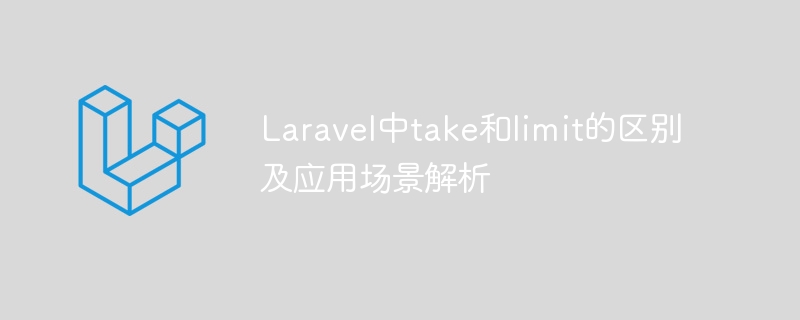Home >PHP Framework >Laravel >The difference between take and limit in Laravel and analysis of application scenarios
The difference between take and limit in Laravel and analysis of application scenarios
- WBOYWBOYWBOYWBOYWBOYWBOYWBOYWBOYWBOYWBOYWBOYWBOYWBOriginal
- 2024-03-09 22:42:03853browse

The difference between take and limit in Laravel and application scenario analysis
In the Laravel framework, we often encounter situations where we need to limit the number of query results. When processing data, take and limit are two commonly used methods. They can both be used to limit the number of query results, but there are some differences in specific application scenarios. This article will analyze in detail the difference between take and limit and their application scenarios in Laravel, and provide corresponding code examples.
1. take method
In Laravel, the take method is used to limit the number of query results. The calling format of the take method is:
$users = User::take(5)->get();
The above code will query the first 5 records of the User model. The function of the take method is to take out a specified number of records from the query results, and the returned result is a collection.
The advantage of the take method is that it can easily specify the number of records to be obtained, and can be used in combination with other query conditions. For example, you can use the take method like this:
$users = User::where('status', 'active')->take(10)->get();The above code will query the first 10 user records with the status 'active'.
2. Limit method
Different from the take method, the limit method is a method used in SQL statements to limit the number of results. In Laravel, we can use the limit method through the DB facade or Query Builder object. The example is as follows:
$users = DB::table('users')->limit(5)->get();The above code will query the first 5 records in the users table.
The limit method has the same function as the take method, both are used to limit the number of query results. However, the limit method needs to be specified in the SQL query, while the take method is used in Laravel's query builder, which can be more flexibly combined with other query conditions.
3. Differences and application scenarios
In actual development, we should choose to use the take or limit method according to the specific situation. Some differences and application scenarios are listed below for reference:
- The take method is used in Laravel's query builder, which is more convenient for building complex query conditions, and returns a collection object, which is convenient Subsequent processing;
- limit method is used in SQL statements and is suitable for use in simple queries, especially when native SQL statements need to be executed;
- take method is usually used in Eloquent Model queries can be used in conjunction with model associations and other query conditions; the
- limit method is suitable for some complex SQL queries, such as those involving multi-table association queries. The number of query results can be specified directly in the SQL statement. .
4. Code example
A simple code example is provided below to demonstrate how to use the take and limit methods in Laravel:
// 使用take方法查询用户表中的前5条记录
$users = User::take(5)->get();
// 使用limit方法查询文章表中的前3条记录
$articles = DB::table('articles')->limit(3)->get();Through the above example, we You can see how to use the take and limit methods to limit the number of query results, and their application scenarios in different queries.
In short, the take and limit methods have their unique application scenarios in Laravel. Choosing the appropriate method to limit the number of query results according to actual needs can handle data query operations more efficiently. Hope this article helps you!
The above is the detailed content of The difference between take and limit in Laravel and analysis of application scenarios. For more information, please follow other related articles on the PHP Chinese website!
Related articles
See more- Difference: view and fetch methods in TP5 controller
- What is the sql statement to delete a field?
- How to set foreign keys in database sql statement
- How to intercept part of a field using sql statement
- The difference between MySql and SQL optimization: The difference between MySQL optimization strategy and SQL optimization strategy

